If I could give two words of advice to a beginning kitchen gardener, it would be “Stake everything!” It’s the very same advice that my September-self always wishes that my June-self would have remembered and acted upon.
Many kitchen garden plants need to be supported in some way to do their best. I’m thinking of tomatoes especially, but we have also found staking our basil, eggplant, and peppers to be very helpful. If we manage to scrounge enough cages, we also support the cabbage or broccoli. Sometimes we use cages early in the season to mark the vulnerable seedlings so they don’t get stepped on, and sometimes we forget to move the cages until too late. By then, the plant has filled out enough that the cage can’t be removed easily.
Why stake up plants? Seedlings are much like children in that, when they are small, trying to imagine them all grown up is nearly impossible. Just like children, however, seedlings do grow– beyond your imagination. Those tiny tomato plants will not stay tiny. Same for those cucumbers, basil, eggplants, and, with luck, everything else you plant. You turn your back, occupied with other daily distractions, and then blammo– you’ve got tomato plants tripping over each other, falling on the ground.
The weather can also take its toll on the heartiest seeming plant. Given the torrential downpours that often mark Michigan summers, staking up as many plants as possible in the kitchen garden helps plants make it through the summer without getting beat up, knocked down or damaged.
Keeping plants standing up off the ground also yields more produce. Contact with soil weakens the skin of vegetables like tomatoes or eggplants, which can encourage decay. Soil contact also makes it easier for certain insects to have easy access to your crop. Some loss is unavoidable but it’s disappointing to share too much of your hard work.
There are different materials and methods available for staking up garden plants. We use a “what-have-ya-got” approach to staking, so our main methods are garden spirals, tomato cages, some home-made wire fencing cages, and wooden stakes. I’ve seen neighbors employing other shapes, like tripods or trellises, but the four types below are what we have on hand this season.
1. Tomato cages. Not just for tomatoes, these cages also support basil, peppers, and eggplant in our garden. Tomato cages are our old stand-by. Over the years we’ve acquired quite a few, and they are good to reuse for many seasons. They are fairly inexpensive to start, and occasionally I’ll see some out by the curb or listed on the ecycle list. Another thing I like about tomato cages is that they ‘stack’ together nicely for storage in our barn attic.
2. Tomato spirals. Oh my goodness, we love tomato spirals, and so do the tomato plants. We have about a dozen tomato spirals that we’ve collected over the years, and we wish we had more. The twisty part works with the tomato plant’s natural growing tendency, so with just a little nudge every now and then, the tomato grows up the spiral and stands tall in the garden. Spirals are particularly useful if you prune your tomato plants. They are not inexpensive, however, so we don’t have a one-to-one ratio of spirals to plants. We acquired some of ours from our local Downtown Home and Garden, but they are also available elsewhere, including Amazon.
3. Wire fencing cages. We purchased a roll of wire fencing and cut it to make our own. Our cages have about a 12-inch diameter. Jim says if he were doing it over again, he’d make the cages bigger. You’d want to have 4 inch to 6 inch squares in the wire pattern for easy access to your plants, i.e., harvesting, pruning. You don’t want something too small to put your hand through. The cages are a little wobbly so we usually use a metal fence post to support several cages.
4. Wooden stakes. Usually my last choice for staking up plants, but good in a pinch. We have some old ones around that we made tripods with in the past, but we didn’t do that this year. You have to be careful pushing wooden stakes into the ground because it can result in splinters or occasional self-stabbing when the stake breaks– and I had a bruise to show for that.
Staking up garden plants is an entirely worthwhile effort that will always pay off more than you think. Other methods abound. What’s are your favorite?
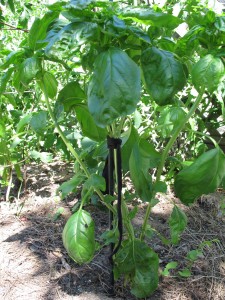
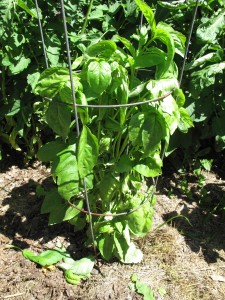

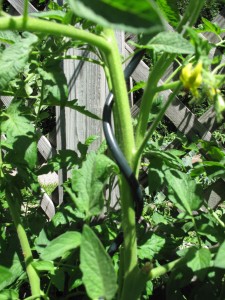
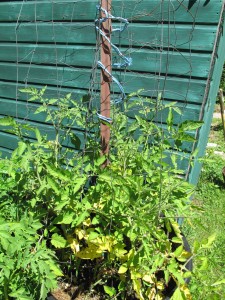
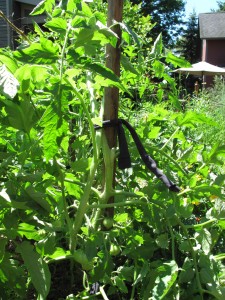



2 Responses
Stay in touch with the conversation, subscribe to the RSS feed for comments on this post.
Continuing the Discussion